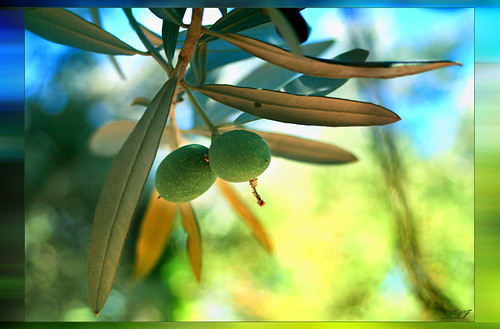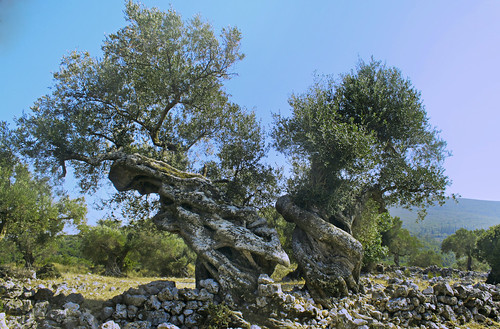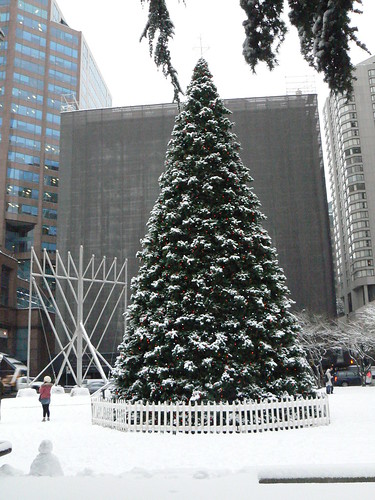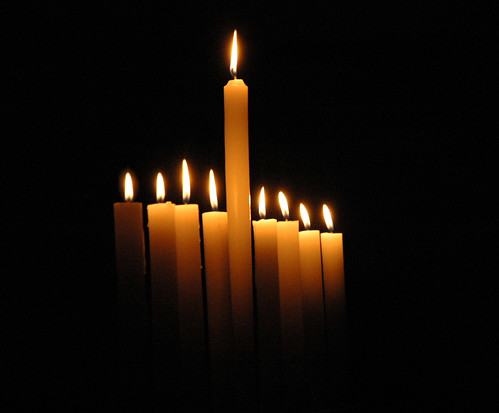Virtues of Olive Oil
Olive (Olea europaea) is native to the east basin of the Mediterranean ocean, whose other fragrant family members include jasmine, lilac and osmanthus (aka sweet olive). Although olives can be grown in other places successfully (i.e.: California), the best olive oils are those grown in the region. I am, of course, impartial to the olive oils grown where I come from: the Western Galilee in Israel. Since biblical times, this was the region of olive oil. Perhaps it’s all Jacob’s fault, as he blessed his son Asher (whose tribe inherited this part of the land): “me Asher shmena lachmo, ve hu yiten ma’adanei melech” (Genesis, XLIX, 20) - Translation: “out of Asher his bread will be fat, and he shall yield royal dainties”.
The plant's uses are not limited to food: the oil was also used in coronation rituals, in cosmetics, toiletries and last but not least - in "oil candles" (see picture above). Pure virgin olive oil of the highest quality was used in the Jewish tabernacle and temple Menorah to keep an eternal light at the holy place. And this is what the Hanukkah story is all about - the miracle of one little can of oil that instead of one day, lasted for 8 days, until consecrated, pure olive oil will be brought from the Western Galilee to Jerusalem.
Although the trees are not very tall (they grow about 8-15m high at the most), they grow a thick trunk that becomes hollow with age. The olive trees require no watering (except for when the trees are very young, in the first couple of years after planting). These are hardy trees that are used to the dry conditions and can survive no rain for many months. Tending the trees, besides the harvest, requires some tending to after the harvest season: pruning the trees, aerating the earth around them by plowing and fertilizing (usually with cow manure) once the harvest is over. Aside from that, the trees are pretty much left to themselves for the rest of the year.
The harvest takes place in the fall, after the first rain washes the dust off the olives and before the rain season begins (which will spoil the fruit). This usually happens in late October and early November. Most olive growers are Druze and Arabic families who grow the same olives on their estate for hundreds of years. The harvest season is intense and quite stressful as all the work has to be done between the 1st rain and the 2nd rain. Failing to do this on time will result in loss of crops or an inferior olive oil. Therefore, the extended family usually drops everything else – work, business and school for the kids – to make sure the olives are all off the trees before the 2nd rain. All ages participate in the harvest, including young children (even toddlers) and the old, who can at least help with sorting out the olives (i.e.: chucking out the spoiled ones and those infested with worms) and putting aside those suitable for pickling. The green (unripe) olives contain more oil than the black ones. Most of the fruit is pressed into oil, but some is pickled (usually you would take out the bigger, nicer looking olives for pickling), and of course the very ripe black ones would be set aside for special preparation (see more below under “Culinary Uses”).
In my region, the harvest season has now been extended into an “Olive Harvest Festival” to celebrate the region’s historical treasure and to promote peace between Arabs and Jews through cultural celebrations such as music, dance, and of course – food with olives and olive oil.
The olives are all brought to the olive pressing house, which functions as an olive-oil co-op. Each family’s crop will be weighed before pressing, and the family will in return get an equivalent percentage to their contribution of the oil produced. A set percentage remains with the pressing house, as a form of payment.
Olive oil is the only oil expressed from a fruit (rather than a seed or a nut). And is the only one that is truly cold pressed. There are three grades of olive oil:
Virgin olive oil, which is produced from lightly pressing on the olives and requires no filtration. It is produced from grinding the olive fruit into a paste, traditionally using millstones, which are now replaced with steel drums. The paste is than placed in a centrifuge to mechanically separate the oil from the paste (the paste sinks to the bottom). This grade is the most desirable grade for food preparation and for consumption, and has the highest levels of antioxidants (which account for its slightly bitter taste). Some virgin olive oils are also filtered to get rid of the cloudy residues. Extra virgin olive oil is processed the same as virgin olive oil, but also “satisfies specific high chemical and organoleptic criteria (low free acidity, no or very little organoleptic defects)” (Wikipedia)
Grade A oil is obtained by further pressing the olive fruit which remained from the virgin oil production, and requires some refinement.
Grade B oil is produced from extracting the remaining fruit in hexane.
Another grade, which is called pomace oil, is produced by using the residue of fruit used fro grade B oils, and also grinding the pits of the olives, which also contain oil on their own. This process may also require some extraction with solvent (hexane). These are mostly valuable for soapmaking and not so much for cooking or cosmetics.
Chemical Makeup:
Contains mixed triglyceride esters of oleic acid and palmitic acid and of other fatty acids, along with traces of squalene (up to 0.7%) and sterols (about 0.2% phytosterol and tocosterols) (Wikipedia).
Health Benefits:
To name a few of the main ones:
- Lowers the “bad” cholesterol levels in the blood while preventing oxidation of the “good” cholesterol in the blood
- Cardioprotective benefits (i.e.: reduces the risk of coronary heart diseases, when used instead of less beneficial fats in one’s diet).
- Helps to balance omega-3 fats and omega-6 fats.
- Anti-oxidant. Interestingly, the elderly Druze in the Galilee touted a morning routine that involved drinking a glass of virgin olive oil on an empty stomach, to promote health and longevity. Also, the oldest woman in recorded history, Jean Calment, credited her longevity and her healthy skin to deliberately use of olive oil in her diet.
Culinary Uses:
The ripe (black) or unripe (green) fruit can be pickled in salt water.
The green olives need to be cracked or slashed and soaked and rinsed in water for several weeks first to remove their bitterness; than pickled in brine (water and salt) and spices of choice (usually wedged lemons, whole cloves of garlic and a few dried hot peppers will suffice) for about 2 months, or until the olives developed their typical pickled-olive colour and their bitterness has subsided drastically.
The black ones can be pickled immediately, or layered with coarse salt in a basket to preserve. After 3 months the black brine olives will be ready to serve: rinsed with water, drained, and than sprinkled with olive oil and fresh herbs of choice (rue leaf is a classic addition).
Olives are an indispensable condiment, served with Mezze (traditional Middle Eastern appetizers and salads), made into tapanades, added to Martinis, sandwiches and more.
Olive oil is best used fresh, rather than a cooking or frying oil. My favourite salad dressing is a simple squeeze of lemon juice from ½ a lemon (if you squeeze it by hand some of the lemon essential oils drip from the peel to the juice) and about 2 Tbs. of extra virgin olive oil. Really you don’t need anything else to make a perfect salad dressing, not even salt or pepper.
I like drizzling olive oil onto pasta after it’s been cooked, with or without the tomato sauce.
A simple bread dip can be made by blending together olive oil and balsamic vinegar and/or soy sauce. A clove of garlic is optional. It’s a great substitute for butter and really goes fantastically well with freshly baked bread. Another condiment I grew up on was “Za’atar”, a combination of wild herbs, primarily hyssop, with a touch of wild mountain thyme and white mint (when available), sumac and sesam seeds. These are either sprinkled on yogurt cheese (“Labaneh”) or mixed into a paste with the olive oil and used as a spread or a dip for pita and other regional flat breads.
Steamed vegetables, when fresh and in season, don’t need much more dressing up besides olive oil. Try using a drizzle of olive oil and a touch of sea salt or fleur de sel on steamed broccoli, brussles sprouts or asparagus. It will transform both your health and your cuisine.
Similarly, you can use olive oil in potato puree. Mash the potatoes with a little bit of the water they were cooked in, a touch of salt, a tablespoon or two of extra virgin olive oil and a dash of thyme. And the same trick with yams is out of this world yummy.
Skin-Care Properties:
Humectant, moisturizing, anti-oxidant. It creates a protective film on the skin, absorbs moisture from the air yet without clogging the skin or interfering with its cell activity (breathing, shedding, regeneration, etc.).

Aegean Pearl -- Baby Olive, originally uploaded by Kuzeytac.
Beauty and Body Care Uses:
Olive oil is used in both skin care and hair care products, incorporated into body lotions, salt and sugar scrubs, shampoos and conditioners. Castile soap was originally a soap made of olive oil as the only fat, and it is a very mild soap though without much lather – it has wonderful cleansing properties without drying the skin and is gentle enough to use on babies. The Druze from the nearby village made castile soap like that from the olive pomace and it was mild enough to wash babies clothes in it (we’d grate it to make soap flakes) but also powerful enough to remove some tough stains.
The oil itself can be used as massage oil, and will keep the skin smooth and moisturized. Applying virgin olive oil to the scalp before shampooing will help reduce dandruff or flaky itchy scalp. It can either be applied as is or warmed up first as a warm hair-mask (cover your hair with plastic bag and a towel to keep the heat on the head). Olive oil can be also applied to the tips of your hair if it’s dry and also as an all-natural, simple styling product (just don’t put too much!).
For more Mediterranean beauty tips incorporating olive oil, read Helg’s excellent “review” of olive oil on Makeup Alley. What else do you use olive oil for? Please share your wisdom by commenting below.










